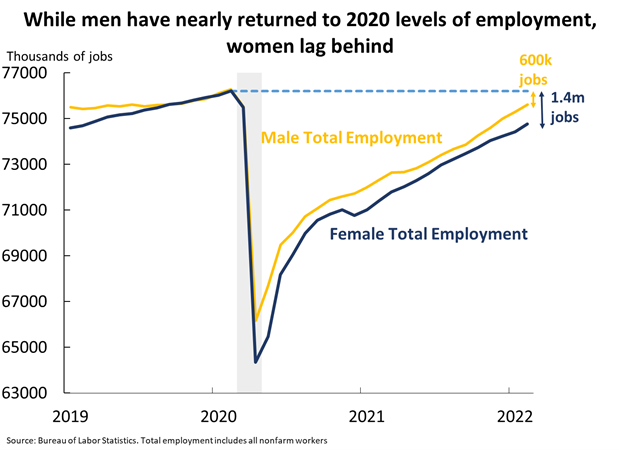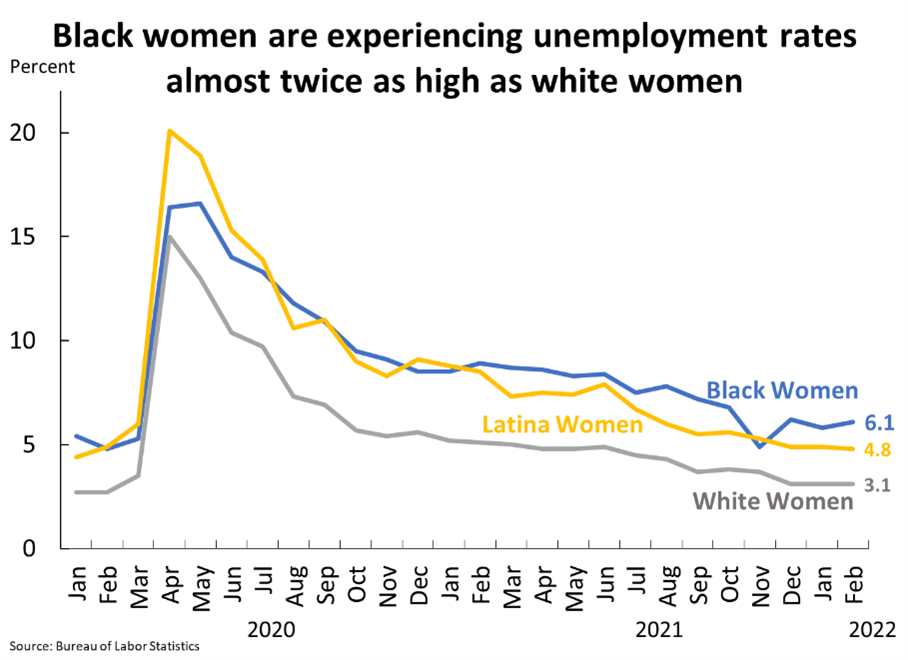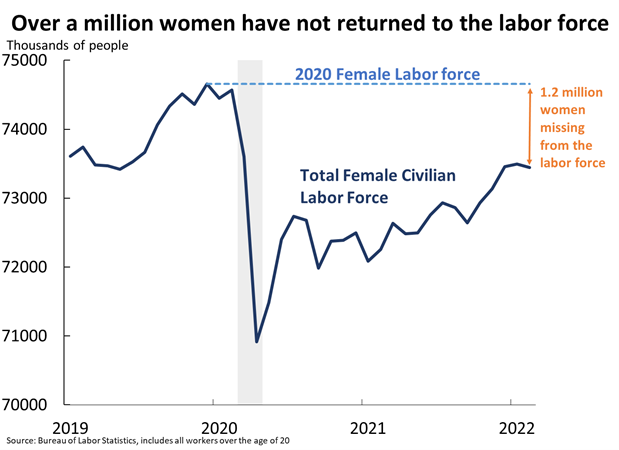Ensuring Women Can Thrive in a Post-Pandemic Economy
The COVID-19 recession was unlike any other recession the United States has experienced to date. Keeping Americans safe and healthy was the priority, even if it meant temporarily shutting down entire sectors of our modern economy. Parts of the economy that are relatively recession-proof under normal downturns, like the service sector, were suddenly among the most affected – in fact, the leisure and hospitality sector, which lost 9 percent of the jobs that existed pre-pandemic, is still 1.5 million jobs short of 2020 levels.[1] Health care workers and educational staff were also among the most affected, suffering from both high levels of stress as they moved to the frontlines of the fight against COVID-19, as well as some of the highest numbers of jobs lost.
Because women make up a disproportionate share of workers in these sectors, and because they on average provide more caregiving for their families than men, the twin health and economic crises continue to have an unequal impact on women. Black mothers are forced to contend with additional barriers and inequities. Half of Black households with minor children are led by single women, who often have to balance child care and virtual schooling with paid work and being a sole provider for their families. The COVID-19 pandemic has magnified underlying inequities that have existed in the United States for generations – in our health care system, our economy, and in access to opportunity. These underlying conditions help explain the disproportionate effects the pandemic and resulting recession have had in Black communities.
Why is an inclusive economy important? We cannot diminish the vital contributions of women – who make up 47 percent of our workforce – to our economy. Working women provide for their families and they have an enormous impact on our GDP: one reason for the sustained economic growth over the last 50 years is because of women's steadily increasing participation in the paid labor force. In short, America will never achieve a full recovery if working women are left behind. Failing to support working parents – especially mothers – will impact our productivity and curb economic growth for decades to come.
The burden of this crisis has disproportionately fallen on the shoulders of women. Women lost 12.2 million jobs at the depth of the recession. They are still 1.4 million jobs below February 2020 levels, whereas men are down about 600,000 jobs. Women accounted for 52 percent of jobs lost at the peak of the crisis, despite making up 47 percent of the labor force at that time.

The effects of the pandemic have also not been felt equally across groups. In aggregate men have a slightly higher unemployment rate than women (3.5 percent compared to 3.6 percent), and not all women are experiencing the same rate of unemployment. White women are currently experiencing an unemployment rate of 3.1 percent, but Black women's unemployment rate is 6.1 percent, while Latina women's unemployment rate is 4.8 percent. These differences are partly because a greater share of Black and Latina women are still in the labor force and looking for work, while white women have been more likely to drop out of the labor force entirely. However, white women are also less likely to be sole earners for their families, which may lead to more flexibility in choosing a job or choosing to work or not.

Women have been pushed out of the labor force at rates higher than men. On net, there are 1.2 million fewer women in the labor force than in February 2020, whereas the total number of men in the labor force has already recovered beyond 2020 levels.

Why has this experience been so much worse for women? To start, women typically take on the brunt of child care. Therefore, it is no surprise that mothers – particularly mothers of young children – constitute a larger share of job loss than men and have been unable to return to work as quickly. Women are also more likely than men to be caring for other family members. At the same time, many of the most impacted careers (such as child care providers, medical staff, domestic workers, educational staff, retail workers, and other frontline jobs, to name a few) are women-dominated careers with women making up the vast majority of frontline and essential workers in the pandemic. Workers in these sectors were more likely to face temporary or permanent job loss. Even when they did not lose their jobs, women in these professions also faced increased health risks, fewer opportunities for remote work, and a lack of paid leave.
How do we ensure an inclusive recovery so women can return to the workforce?
While COVID-19 and its variants remain a danger to public health, the creation and wide distribution of vaccines and the direct support for families, small businesses, states, and local communities included in the American Rescue Plan have helped our economy recover at a historic rate and create millions of jobs.
The American Rescue Plan helped get the country through the worst phase of the pandemic. It provided support to families by distributing economic incentive payments, increasing and expanding existing tax credits to workers and families (including the child poverty-reducing Child Tax Credit), and lowering health care costs for many Americans. The Rescue Plan also helped small businesses retain workers and purchase necessary supplies to stay open during the pandemic. This was key to the economic improvement we have seen, and it cushioned the blow of the pandemic for many Americans. Yet more work remains to be done to address the underlying problems for women that existed before the pandemic and have been exacerbated over the past two years. Moving forward, Congress must remain focused on building an inclusive economy that works for everyone.
Indeed, there are many policies that can support women going forward. As President Biden said at his March 1st State of the Union address, "many families pay up to $14,000 a year for child care per child." Democrats have called for and will continue to fight for investments in women and children. Last year, House Democrats voted to limit the amount middle-class and working families pay to not more than 7 percent of their income for care of young children. Democrats have also called for and will continue to fight for universal pre-kindergarten for all three- and four-year-old children. This helps make it possible for mothers to work, but it also has long-run benefits, like improving educational outcomes for our children, resulting in more productive citizens. Paid leave is also a critical component. We know the statistics [2]; the U.S. is one of just seven countries that offer no paid leave. Among rich countries, we stand out for our lack of support to working families. This is critical for both moms and dads who need to take time off to care for family members and who should be able to do so without fear of losing their jobs. Lastly, these investments help families balance work and home, but we must help them balance their checkbook too. As President Biden said, the Senate needs to enact the Paycheck Fairness Act. These policies would be critical steps to rebuilding an economy where women can thrive.
On March 16th, the House Budget Committee will hear testimony on how the public health and economic crises brought on by COVID-19 have exacerbated underlying and systemic challenges facing American women. Witnesses will discuss the ways in which the COVID-19 recession disproportionately affected women, the importance of an inclusive recovery to the well-being and future of our economy, and federal policy options to ensure women are not left behind in recovery efforts or forced to shoulder a greater burden because of their sex. Witnesses will include:
- Dr. Stefania Albanesi, Professor of Economics, University of Pittsburgh
- Ms. Ai-jen Poo, Executive Director of the National Domestic Workers Alliance
- Ms. Rosa Walker, Mother and MomsRising Member
- Mrs. Carrie Lukas, President of the Independent Women's Forum
[1] Data as of February 2022 Bureau of Labor Statistics Employment Report
[2]Besides the United States, the only other countries with no national paid maternity leave are the Marshall Islands, Micronesia, Nauru, Palau, Papua New Guinea and Tonga, according to https://www.nytimes.com/2021/10/25/upshot/paid-leave-democrats.html Data on family-friendly leave for rich countries from: https://www.unicef-irc.org/family-friendly.